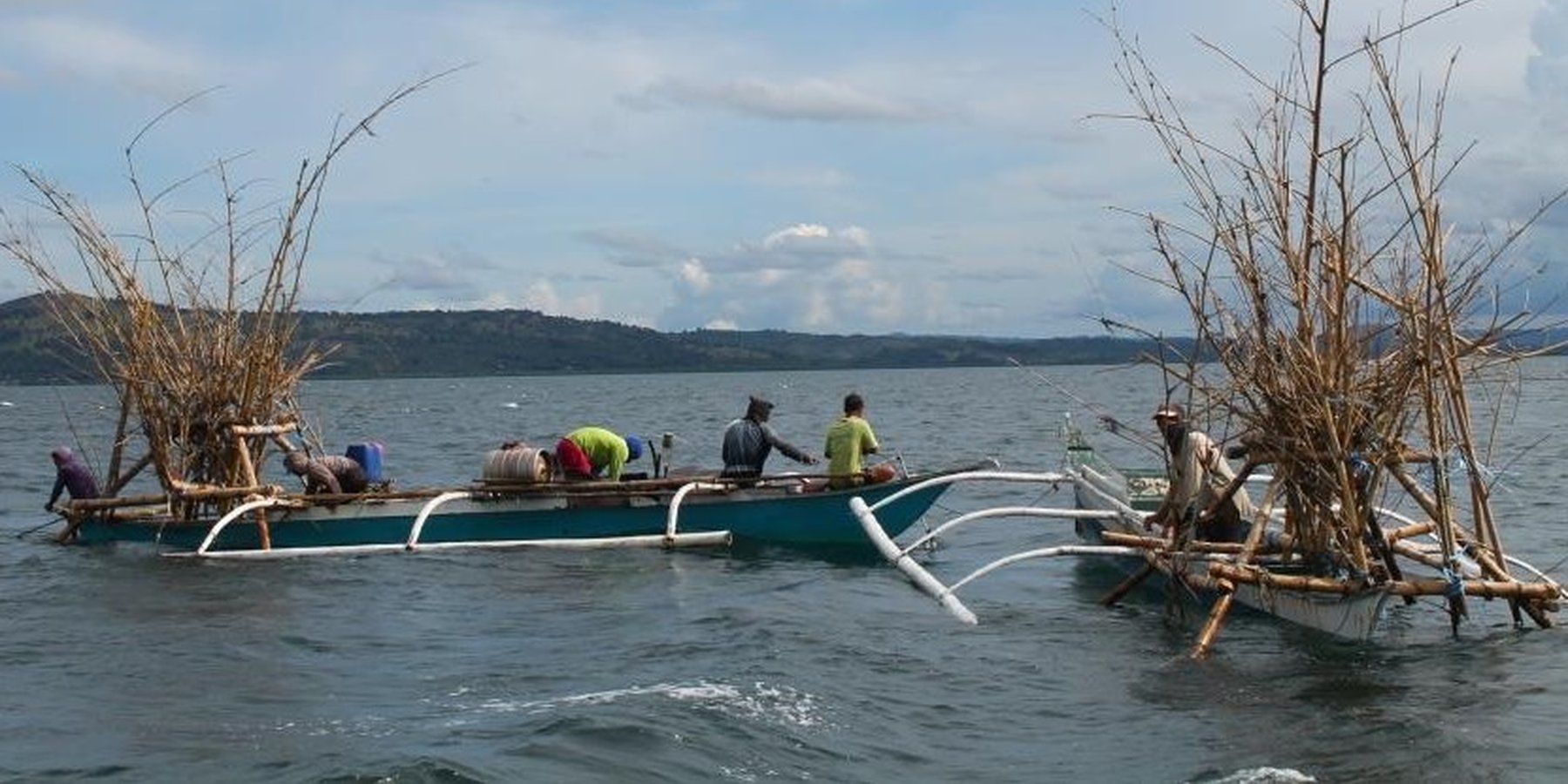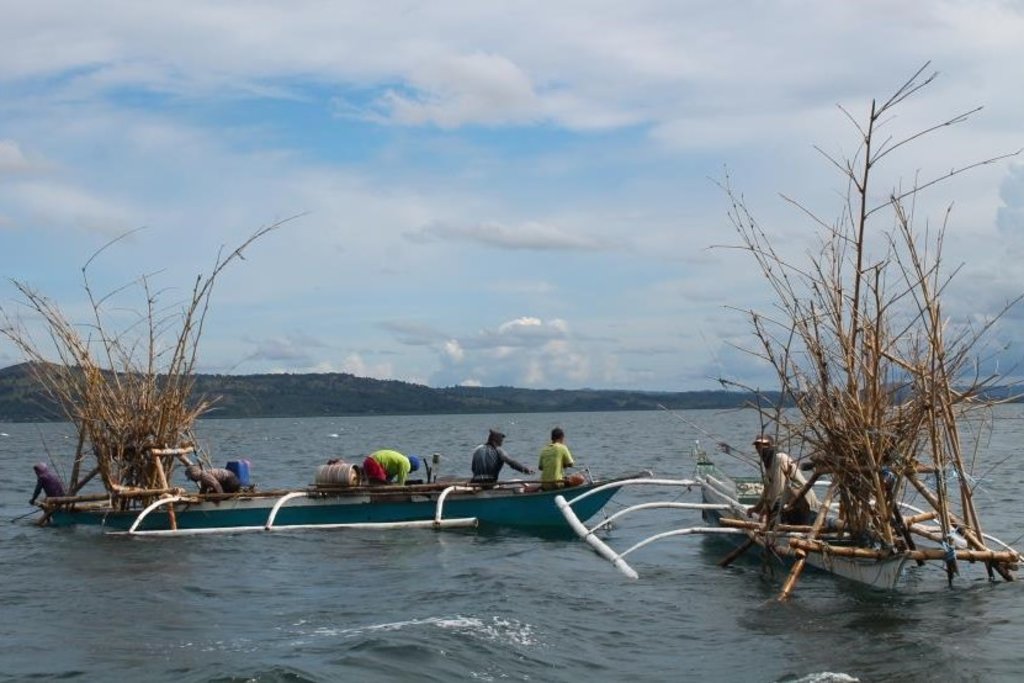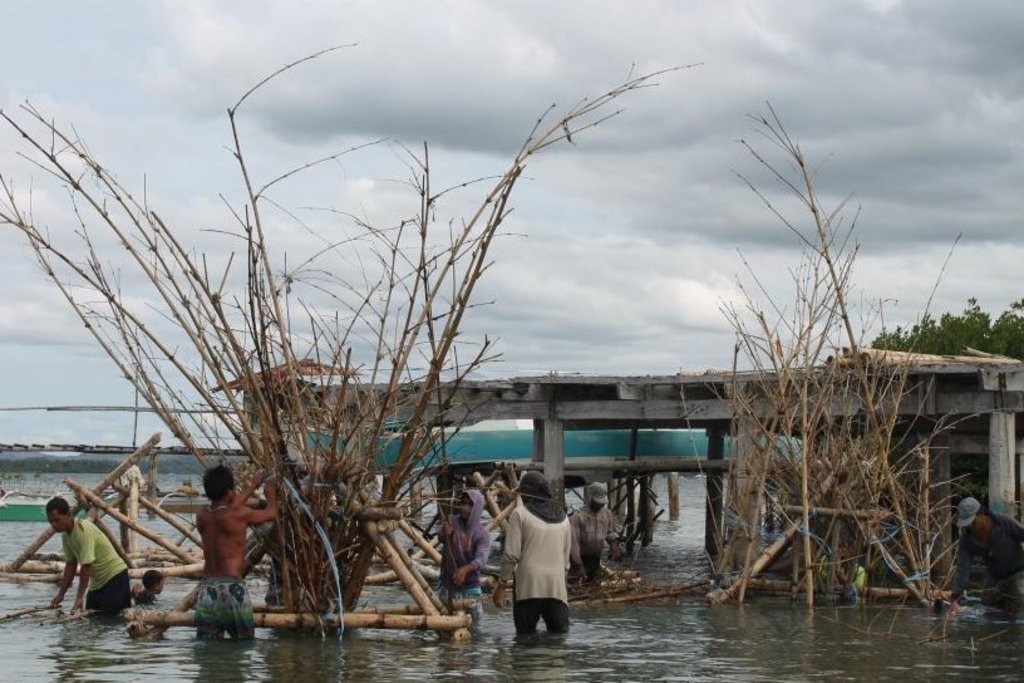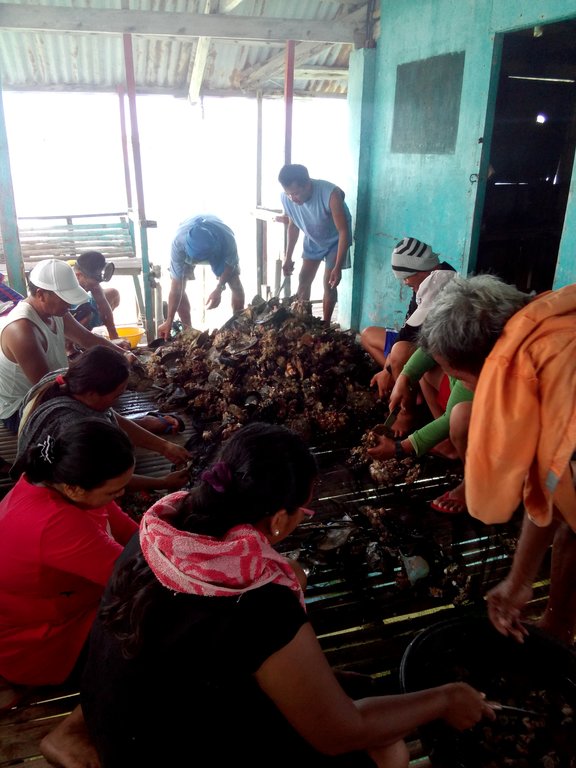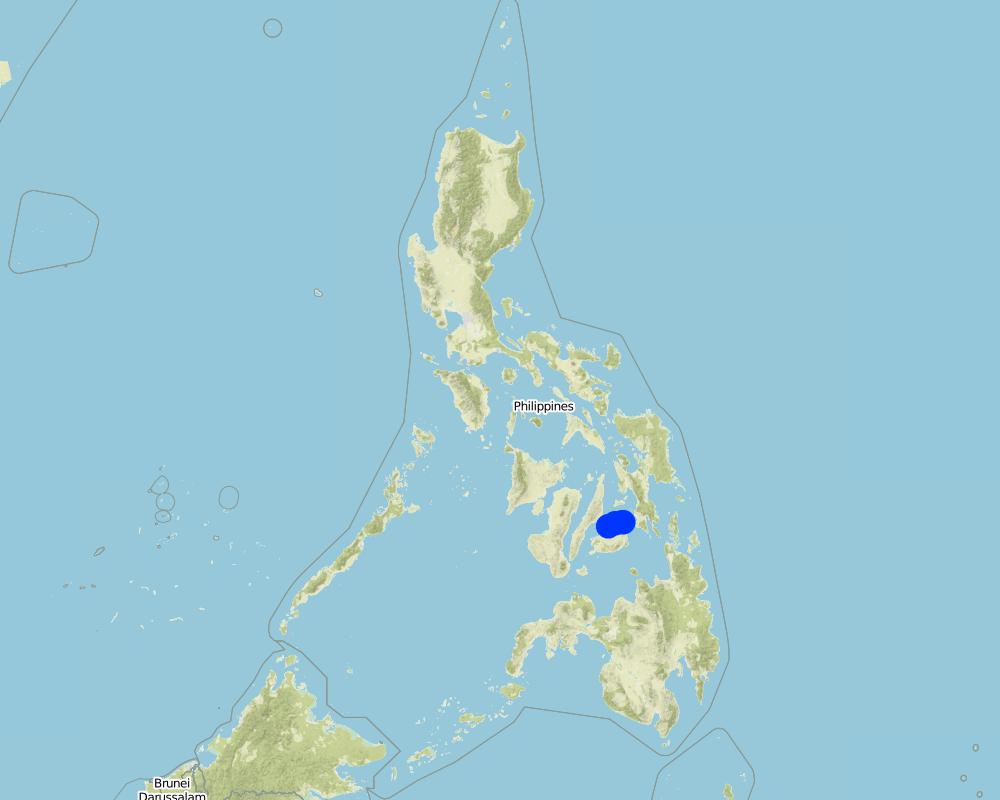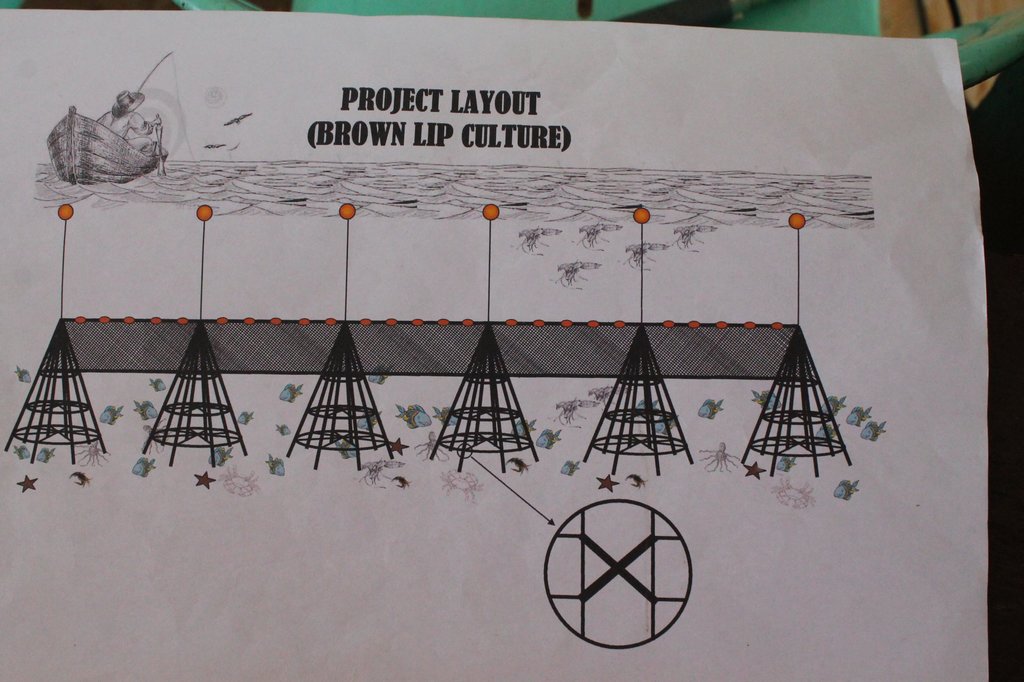Artificial Reef [Filipinas]
- Criação:
- Atualização:
- Compilador/a: Keeshia Lynn Marie Austria
- Editor: –
- Revisor: Alexandra Gavilano
Gango
technologies_3116 - Filipinas
Veja as seções
Expandir tudo Recolher tudo1. Informação geral
1.2 Detalhes do contato das pessoas capacitadas e instituições envolvidas na avaliação e documentação da tecnologia
Pessoa(s) capacitada(s)
Sustainable Livelihood Officer (SLO):
usuário de terra:
Nome do projeto que facilitou a documentação/avaliação da Tecnologia (se relevante)
Danajon Communities WATCH ( DCW)Nome da(s) instituição(ões) que facilitou(ram) a documentação/ avaliação da Tecnologia (se relevante)
Philippine Partnership for the Development of Human Resoruces in Rural Areasy (PhilDHRRA) - Filipinas1.3 Condições em relação ao uso da informação documentada através de WOCAT
O compilador e a(s) pessoa(s) capacitada(s) aceitam as condições relativas ao uso de dados documentados através do WOCAT:
Sim
1.4 Declaração de sustentabilidade da tecnologia descrita
A tecnologia descrita aqui é problemática em relação a degradação da terra de forma que não pode ser declarada uma tecnologia de gestão sustentável de terra?
Não
Comentários:
Artificial Reef is installed at the bottom of the sea and anchored in all corners, thus, any weather and climate condition can not directly affect the situation of the technology as an alternative marine habitat.
1.5 Referência ao(s) questionário(s) sobre abordagens GST (documentado(s) usando WOCAT)
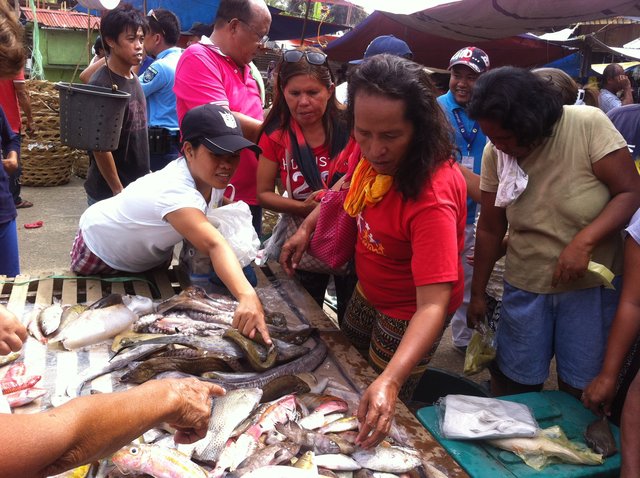
Social Enterprise (SE) [Filipinas]
Social Enterprise (SE) aimed to provide social protection among its members and generate additional family income. Above all, this approach will encourage the conservation, preservation and protection of the resources available in the community.
- Compilador/a: Keeshia Lynn Marie Austria
2. Descrição da tecnologia de GST
2.1 Descrição curta da tecnologia
Definição da tecnologia:
Artificial Reef is a fish aggregating device that is considered as a sustainable alternative in the islands of Bohol. This technology can withstand the effects of gale warning, typhoons and extreme heat.
2.2 Descrição detalhada da tecnologia
Descrição:
The fishers of Bohol have been using Artificial Reef over a long period of time. This is a fish aggregating device but at the same time, used for brown lip culture. Aside from the above mentioned functions of Artificial Reef, the Island of Bilangbilangan East in Bien Unido, Bohol installed this technology around the buffer zone of the marine sanctuary because the floater will serve as indicator of the marine protected area.
Artificial Reef Technology is a project of Bilangbilangan East Fishers Association (BEFA) from Brgy. Bilangbilangan East, Bien Unido, Bohol; Calituban Fisherfolks Association (CFO) from Brgy. Calituban, Talibon, Bohol and Nasingin Fisherfolks and Mangrove Planters Association (NasFiMPA) from Brgy. Nasingin, Getafe. This technology is owned and managed by the People's Organization found in these three island barangays namely BEFA, CFO and NasFiMPA.
Artificial Reef if is primarily made of bamboo with a life span of 3 to 5 years. For stability, it is anchored in the four corners using a cemented container tied to every end of its corners. For markings, floaters are placed in the sea surface but Nasingin and Calituban fishers preferred not to use floaters for the security of their installed artificial reefs, rather, they used terrestrial points to identify the location.
This technology was installed within the municipal waters (15 kilometers from the shoreline) to help minimize fishing cost and avoid the hazards of sudden change in weather condition. The PO are now vigilant because they already installed Artificial Reefs before but were destroyed by the dynamite fishers. This encouraged the PO members to practice safe and legal forms of fishing in order to sustain their project. Above all, artificial reef will enhance fish spawning and provide alternative shelter to fishes during hot season.
2.3 Fotos da tecnologia
Observações gerais sobre as fotos:
Brown lips will naturally grow in the artificial reef. After 3 months of installation, fishers can already harvest fish while the first harvest of brown lip can be done a year after the installation.
2.4 Vídeos da tecnologia
Comentários, breve descrição:
Monitoring of the Artificial Reef in Bilangbilangan Island, Bien Unido, Bohol after 3 months of installation.
A Social Enterprise Project of Danajon Communities WATCH (DCW) Project. Implemented by PhilDHRRA, LPFI and A2D Project. In Partnership with Caritas Switzerland and JTIF.
Data:
01/06/2016
Localização:
Brgy. Bilangbilangan East, Bien Unido, Bohol
Nome do cinegrafista:
Bilangbilangan East Fisherfolks Association (BEFA)
2.5 País/região/locais onde a tecnologia foi aplicada e que estão cobertos nesta avaliação
País:
Filipinas
Região/Estado/Província:
Bohol
Especificação adicional de localização:
Brgy. Bilangbilangan East, Municipality of Bien Unido; Brgy. Calituban, Municipality of Talibon; Brgy. Nasingin, Municipality of Getafe
Especifique a difusão da tecnologia:
- Aplicado em pontos específicos/concentrado numa pequena área
Comentários:
The team decided to get the coordinates of the 2 ends and middle part of the Artificial Reef installed due to the weather and current of the tide. Also, these technologies were installed in a linear position.
Each Artificial Reef was installed 10 meters apart from each other.
Map
×2.6 Data da implementação
Indique o ano de implementação:
2017
2.7 Introdução da tecnologia
Especifique como a tecnologia foi introduzida:
- Como parte do sistema tradicional (>50 anos)
Comentários (tipos de projeto, etc.):
The 3 areas have tried this kind of method even before DCW Project. However, it was not sustained mainly because of illegal fishing and illegal entry of fishers from the neighboring municipalities and barangays.
3. Classificação da tecnologia de GST
3.1 Principal/principais finalidade(s) da tecnologia
- Melhora a produção
- Preservar/melhorar a biodiversidade
- Adaptar a mudanças climáticas/extremos e seus impactos
- Cria impacto social benéfico
3.2 Tipo(s) atualizado(s) de uso da terra onde a tecnologia foi aplicada

Vias navegáveis, corpo d'água, zonas úmidas
- sea
Principais produtos/serviços:
Brown lip culture and fish aggregating device, fish
3.3 O uso do solo mudou devido à implementação da Tecnologia?
O uso do solo mudou devido à implementação da Tecnologia?
- Sim (Por favor, preencha as perguntas abaixo com relação ao uso do solo antes da implementação da Tecnologia)

Outros
Especifique:
Before the installation of Artificial Reefs, the fishers are obliged to go beyond the municipal waters which increased their production cost and risk to sudden change of weather. The Artificial Reef was installed within the municipal waters (15 kilometers from the shore line), fishers will lessen their production cost particularly their fuel consumption. This technology also increased fish spawning and marine conservation.
3.4 Abastecimento de água
Outros (p. ex. pós-inundação):
- not applicable
3.5 Grupo de GST ao qual pertence a tecnologia
- variedades vegetal/raças de animais melhoradas
- Gestão de água de superfície (nascente, rio, lagos, mar)
- Redução de riscos de desastre baseada no ecossitema
3.6 Medidas de GST contendo a tecnologia

Medidas estruturais
- S9: Abrigo para plantas e animais
3.8 Redução, prevenção ou recuperação da degradação do solo
Especifique o objetivo da tecnologia em relação a degradação da terra:
- Não aplicável
4. Especificações técnicas, implementação de atividades, entradas e custos
4.1 Desenho técnico da tecnologia
Especificações técnicas (relacionada ao desenho técnico):
Materials: bamboo pole, spiny bamboo, nylon #10 and coral stone as sinker
For this project with seed capital worth Php 30,000, 10 Artificial Reefs are targeted to be installed in a linear position.
Artificial Reef is pyramid in shape with the following dimensions:
Height: 12 - 15 feet
Base: 6.6 feet
Installation process:
Interval: 10 meters
Depth: 12 - 15 meters
Autor:
Calituban Fisherfolks Organization
Data:
09/05/2015
4.2 Informação geral em relação ao cálculo de entradas e custos
Especifique como custos e entradas foram calculados:
- Por unidade de tecnologia
Especifique a unidade:
Php 3,200 per unit inclusive of installation; Php 32,000 for the 10 Artificial Reefs installed
Especificar as dimensões da unidade (se for relevante):
Length of spread: 90 meters
Outro/moeda nacional (especifique):
Philippine Peso
Se for relevante, indique a taxa de câmbio do USD para moeda local (por exemplo, 1 USD = 79,9 Real): 1 USD =:
51,0
Indique a média salarial da mão-de-obra contratada por dia:
Php 250.00
4.3 Atividades de implantação
| Atividade | Periodicidade (estação do ano) | |
|---|---|---|
| 1. | canvass of bamboo poles and spiny bamboo | before construction |
| 2. | purchase of construction materials | before construction |
| 3. | construction of artificial reefs | every 3-5 years |
| 4. | site selection | |
| 5. | installation of artificial reefs | |
| 6. | monitoring | 3 months after installation; monthly basis afterwards per artificial reef |
| 7. | harvest | 3 months after installation; monthly basis afterwards per artificial reef |
4.4 Custos e entradas necessárias para a implantação
| Especifique a entrada | Unidade | Quantidade | Custos por unidade | Custos totais por entrada | % dos custos arcados pelos usuários da terra | |
|---|---|---|---|---|---|---|
| Equipamento | motorboat rental | piece | 2,0 | 300,0 | 600,0 | |
| Material de construção | Bamboo Pole | piece | 10,0 | 120,0 | 1200,0 | |
| Material de construção | Spiny Bamboo | piece | 4,0 | 50,0 | 200,0 | |
| Material de construção | Nylon #10 | kilo | 10,0 | 120,0 | 1200,0 | |
| Custos totais para a implantação da tecnologia | 3200,0 | |||||
| Custos totais para o estabelecimento da Tecnologia em USD | 62,75 | |||||
Comentários:
No labor cost because the organization agreed that they will do it voluntarily.
4.5 Atividades recorrentes/manutenção
| Atividade | Periodicidade/frequência | |
|---|---|---|
| 1. | Monitoring | 3 months after installation, monthly basis after that |
4.6 Custos e entradas necessárias pata a manutenção/atividades recorrentes (por ano)
| Especifique a entrada | Unidade | Quantidade | Custos por unidade | Custos totais por entrada | % dos custos arcados pelos usuários da terra | |
|---|---|---|---|---|---|---|
| Mão-de-obra | monitoring | persons-day | 2,0 | 250,0 | 500,0 | |
| Custos totais para a manutenção da tecnologia | 500,0 | |||||
| Custos totais de manutenção da Tecnologia em USD | 9,8 | |||||
4.7 Fatores mais importantes que afetam os custos
Descreva os fatores mais determinantes que afetam os custos:
Supply of bamboo poles and spiny bamboo since they have to find it from the interior part of the mainland.
5. Ambiente natural e humano
5.1 Clima
Precipitação pluviométrica anual
- <250 mm
- 251-500 mm
- 501-750 mm
- 751-1.000 mm
- 1.001-1.500 mm
- 1.501-2.000 mm
- 2.001-3.000 mm
- 3.001-4.000 mm
- > 4.000 mm
Especifique a média pluviométrica anual em mm (se conhecida):
9999,00
Especificações/comentários sobre a pluviosidade:
as of 2016 data
Indique o nome da estação meteorológica de referência considerada:
https://weather-and-climate.com
Zona agroclimática
- úmido
5.2 Topografia
Declividade média:
- Plano (0-2%)
- Suave ondulado (3-5%)
- Ondulado (6-10%)
- Moderadamente ondulado (11-15%)
- Forte ondulado (16-30%)
- Montanhoso (31-60%)
- Escarpado (>60%)
Formas de relevo:
- Planalto/planície
- Cumes
- Encosta de serra
- Encosta de morro
- Sopés
- Fundos de vale
Zona de altitude:
- 0-100 m s.n.m.
- 101-500 m s.n.m.
- 501-1.000 m s.n.m.
- 1.001-1.500 m s.n.m.
- 1.501-2.000 m s.n.m.
- 2.001-2.500 m s.n.m.
- 2.501-3.000 m s.n.m.
- 3.001-4.000 m s.n.m.
- > 4.000 m s.n.m.
Indique se a tecnologia é aplicada especificamente em:
- Não relevante
Comentários e outras especificações sobre a topografia:
The technology must be installed along the path.
5.3 Solos
Caso disponível anexe a descrição completa do solo ou especifique as informações disponíveis, p. ex. tipo de solo, PH/acidez do solo, nitrogênio, capacidade de troca catiônica, salinidade, etc.
Not Applicable
5.4 Disponibilidade e qualidade de água
Comentários e outras especificações sobre a qualidade e a quantidade da água:
Not Applicable
5.5 Biodiversidade
Diversidade de espécies:
- Alto
Diversidade de habitat:
- Médio
5.6 Características dos usuários da terra que utilizam a tecnologia
Sedentário ou nômade:
- Sedentário
Orientação de mercado do sistema de produção:
- misto (subsistência/comercial)
Rendimento não agrícola:
- Menos de 10% de toda renda
Nível relativo de riqueza:
- Pobre
Indivíduos ou grupos:
- Grupos/comunidade
Nível de mecanização:
- Trabalho manual
Gênero:
- Mulheres
- Homens
Idade dos usuários da terra:
- meia-idade
- idosos
5.7 Área média de terrenos utilizados pelos usuários de terrenos que aplicam a Tecnologia
- < 0,5 ha
- 0,5-1 ha
- 1-2 ha
- 2-5 ha
- 5-15 ha
- 15-50 ha
- 50-100 ha
- 100-500 ha
- 500-1.000 ha
- 1.000-10.000 ha
- > 10.000 ha
É considerado pequena, média ou grande escala (referente ao contexto local)?
- Pequena escala
5.8 Propriedade de terra, direitos de uso da terra e de uso da água
Propriedade da terra:
- Grupo
Direitos do uso da terra:
- Comunitário (organizado)
Direitos do uso da água:
- Acesso livre (não organizado)
5.9 Acesso a serviços e infraestrutura
Saúde:
- Pobre
- Moderado
- Bom
Educação:
- Pobre
- Moderado
- Bom
Assistência técnica:
- Pobre
- Moderado
- Bom
Emprego (p. ex. não agrícola):
- Pobre
- Moderado
- Bom
Mercados:
- Pobre
- Moderado
- Bom
Energia:
- Pobre
- Moderado
- Bom
Vias e transporte:
- Pobre
- Moderado
- Bom
Água potável e saneamento:
- Pobre
- Moderado
- Bom
Serviços financeiros:
- Pobre
- Moderado
- Bom
Solid Waste Management:
- Pobre
- Moderado
- Bom
6. Impactos e declarações finais
6.1 Impactos no local mostrados pela tecnologia
Impactos socioeconômicos
Produção
Produção animal
Diversidade de produtos
Área de produção
Comentários/especificar:
By installing artificial reefs the fishers are not obliged to go further.
Renda e custos
Despesas com insumos agrícolas
Comentários/especificar:
decrease in fuel consumption
Impactos socioculturais
Segurança alimentar/auto-suficiência
Comentários/especificar:
The fishers can catch fish even if there is gale warning.
risk exposure to sudden change of weather conditions
Impactos ecológicos
Clima e redução de riscos de desastre
Impactos de ciclones, temporais
Comentários/especificar:
The technology will not be affected directly or indirectly by the effects of gale warning and typhoon.
6.2 Impactos externos mostrados pela tecnologia
Especificar a avaliação dos impactos fora do local (medidas):
Not Applicable
6.3 Exposição e sensibilidade da tecnologia às mudanças climáticas graduais e extremos/desastres relacionados ao clima (conforme o ponto de vista dos usuários da terra)
Mudança climática gradual
Mudança climática gradual
| Estação do ano | aumento ou diminuição | Como a tecnologia lida com isso? | |
|---|---|---|---|
| Temperatura anual | aumento | muito bem | |
| Precipitação pluviométrica sazonal | estação úmida/das chuvas | redução/diminuição | muito bem |
Extremos (desastres) relacionados ao clima
Desastres meteorológicos
| Como a tecnologia lida com isso? | |
|---|---|
| Tempestade tropical | muito bem |
| Trovoada local | muito bem |
| Tempestade de vento local | muito bem |
Desastres climatológicos
| Como a tecnologia lida com isso? | |
|---|---|
| Seca | muito bem |
Outras consequências relacionadas ao clima
Outras consequências relacionadas ao clima
| Como a tecnologia lida com isso? | |
|---|---|
| Elevação do nível do mar | muito bem |
6.4 Análise do custo-benefício
Como os benefícios se comparam aos custos de implantação (do ponto de vista dos usuários da terra)?
Retornos a curto prazo:
levemente positivo
Retornos a longo prazo:
muito positivo
Como os benefícios se comparam aos custos recorrentes/de manutenção(do ponto de vista dos usuários da terra)?
Retornos a curto prazo:
positivo
Retornos a longo prazo:
muito positivo
6.5 Adoção da tecnologia
- > 50%
Se disponível, determine a quantidade (número de unidades familiares e/ou área abordada):
It's an organizational project with 80 - 120 members each organization.
De todos aqueles que adotaram a Tecnologia, quantos o fizeram espontaneamente, ou seja, sem receber nenhum incentivo/ pagamento material?
- 11-50%
6.6 Adaptação
A tecnologia foi recentemente modificada para adaptar-se as condições variáveis?
Sim
Caso afirmativo, indique as condições variáveis as quais ela foi adaptada:
- Mudança climática/extremo
Especifique a adaptação da tecnologia (desenho, material/espécie, etc):
Instead of using bamboo poles, one organization decided to cement the poles because it is very difficult to find bamboo in the mainland. Also, bamboo will only last for 2-3 years.
Another organization planned to use plastic straps instead of spiny bamboo so that it will be easier and convenient for them to harvest. Another reason is the availability of brown lip spawn that will stream either at the bottom of the sea, in the middle or along the sea water level. The PO strategize to use plastic straps because they will just hang it above the artificial reef to have better harvest on brown lip.
6.7 Pontos fortes/vantagens/oportunidades da tecnologia
| Pontos fortes/vantagens/oportunidades na visão do usuário da terra |
|---|
| According to the management team, the advantage is having alternative site for fishing even if there is gale warning. |
| It will minimize expenses because of lesser fuel consumption. |
| Having an Artificial Reef (AR) project encouraged the members, including their wives to protect the artificial reef site from illegal fishers especially dynamite fishing and trawling. As a result, the people became aware of the effects of illegal fishing and the destruction it will bring to their marine ecosystem. |
| The longer the Artificial Reef (AR) stayed undisturbed, the greater the income. |
| Pontos fortes/vantagens/oportunidades na visão do compilador ou de outra pessoa capacitada |
|---|
| Artificial reef enhanced fish spawning, food chain and improved marine ecosystem. |
| Catalyst of behavioral change among the members of the People's Organization namely BEFA, CFO and NasFiMPA. |
| The organization work together for the preservation, protection and conservation of the project site. |
6.8 Pontos fracos, desvantagens/riscos da tecnologia e formas de superá-los
| Pontos fracos/desvantagens/riscos na visão do usuário da terra | Como eles podem ser superados? |
|---|---|
| Monitoring assignment of the members. | Be strict with the Sustainable Enterprise (SE) Management policy. |
| The harvest cost is very expensive because it needs diving gears and large fishing nets. | Collaborate with Bureau of Fisheries and Aquatic Resources (BFAR) for harvest paraphernalia. |
| The organization has no police power to arrest the intruders and illegal fishers that will take advantage. |
Close coordination with the municipal fish wardens (Bantay Dagat). The organization will establish security measures to protect their Artificial Reefs (AR) installed. |
| Pontos fracos/vantagens/riscos na visão do compilador ou de outra pessoa capacitada | Como eles podem ser superados? |
|---|---|
| The duty bearers should implement Philippine Fisheries Code of 1998 (Republic Act No. 8550). | Capacitate the People's Organization to lobby and and implement the law. |
| The local government unit lacks support mechanism for resource-based technologies promoting environment friendly and disaster resilient enterprise. | Partnership among the local government units, people's organization and non-government organizations. |
| Limited exposure to market, business ideas and linkaging. | Conduct Value Chain Analysis (VCA) training, financial coaching, Occupational Safety and Health Standards (OSHS) and on-site mentoring. |
7. Referências e links
7.1 Métodos/fontes de informação
- visitas de campo, pesquisas de campo
monthly monitoring visits to project sites
- entrevistas com usuários de terras
2 respondent per area
- entrevistas com especialistas em GST
Sustainable Livelihood Officer
Quando os dados foram compilados (no campo)?
05/04/2017
Links e módulos
Expandir tudo Recolher tudoLinks

Social Enterprise (SE) [Filipinas]
Social Enterprise (SE) aimed to provide social protection among its members and generate additional family income. Above all, this approach will encourage the conservation, preservation and protection of the resources available in the community.
- Compilador/a: Keeshia Lynn Marie Austria
Módulos
Não há módulos


